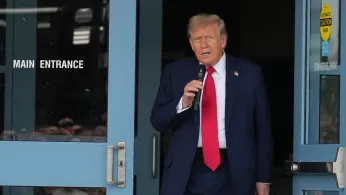
3 hours ago
The Latest: FBI Searches Home and Office of Ex-Trump National Security Adviser John Bolton
The Associated Press READ TIME: 12 MIN.
The FBI is searching the Maryland home and Washington office of John Bolton, who served in President Donald Trump’s first administration as national security adviser, as part of an investigation into the handling of classified information, a person familiar with the matter said Friday.
Bolton emerged as an outspoken critic of Trump after being fired in 2019 and feuded with the first Trump administration over a scathing book he wrote documenting his time in the White House.
He was not in custody Friday and has not been charged with any crimes, said the person, who was not authorized to discuss the investigation by name and spoke to The Associated Press on the condition of anonymity.
The searches, seemingly the most significant public step the Justice Department has taken against a perceived enemy of the president, are likely to elicit fresh alarm that the Trump administration is using its law enforcement powers to go after his foes. The searches of Bolton’s home and office come as the Trump administration has taken steps to examine the activities of other critics, including by authorizing a grand jury investigation into the origins of the Trump-Russia probe that dogged Trump for much of his first term.
Here's the latest:
Trump administration says George Mason University illegally used race in hiring and policies
The Education Department’s Office of Civil Rights issued the finding against the public university in Virginia.
The department says the university must review its policies, conduct annual trainings and issue a statement that includes a personal apology from the president. It directs the university to comply within 10 days.
University officials did not respond immediately to an email request for comment on Friday.
The federal investigation follows a complaint by multiple professors accusing the university of favoring faculty candidates based on diversity considerations rather than their credentials.
Trump asks for $2 billion for DC from the same Congress that took $1billion from city budget
President Trump’s announcement Friday that he would seek $2 billion from Congress to beautify Washington D.C. will likely be received with ironic eyerolls from the local government. Mayor Muriel Bowser and the D.C. Council have spent most of 2025 (prior to the current federal takeover crisis) dealing with an artificial budget crisis created by this Congress.
An obscure change in a federal government funding bill forced the district’s government to revert to its 2024 budget parameters, effectively cutting $1.1 billion from its previously balanced budget midway through the financial year.
The Senate approved the funding bill with the cut but immediately followed up with a separate bill that would make the district’s budget whole again. That bill has languished in the House of Representatives for months while Bowser was forced to make drastic moves to avoid layoffs. The hard feelings over the issue remain intense.
Canada will match US exemptions to punishing tariffs, Canadian official says
Canada is dropping retaliatory tariffs to match U.S. tariff exemptions for goods covered under the United States-Mexico-Canada trade pact, a government official familiar with the matter said Friday.
The official said Canada will include the carve-out that the U.S. has on Canadian goods under the 2020 free trade deal that shields the vast majority of goods from the punishing duties.
The official spoke on condition of anonymity because they weren’t authorized to speak publicly ahead of the expected announcement by Canadian Prime Minister Mark Carney.
▶ Read more about trade between the U.S. and Canada
Trump says he’ll be leading more White House renovations
“We’re doing some very detailed renovations, fixing things are broken. Fixing floors that are cracked up and not good anymore, and in many cases, they were done in the 50s and 60s and 70s,” Trump told reporters Friday. “We’ll be doing the Lincoln Bathroom which was Art Deco.”
He said of the project, “We’re making it actually incredible.”
According to the White House, the refurbishing of the Lincoln Bedroom and the adjoining sitting room — which featured strong period decor derived and adapted from the historical evidence of the Lincoln era — was completed in November 2005.
Trump suggested the Lincoln Bathroom work could “be done in about a week, two weeks” and said he was considering “doing something on the Executive Office Building” across the street from the White House saying it’d be “all cosmetic.”
Trump has already made extensive changes to the White House, including installing patio seating around the Rose Garden and promising to build a ballroom.
Trump sets $2 billion price tag for beautifying DC
“We’re going to be raising about $2 billion from Congress,” the president told reporters. “Congress is happy to do it.”
Trump has talked about refinishing the roads and sprucing up light poles around the capital.
“It hasn’t been clean” he said. “Now it’s going to be clean.”
Trump had a visible smear of makeup on his hand
The president for a while has been covering bruising on the back of his hand with makeup that doesn’t match his skin tone.
A large spread of makeup could be seen on the back of his hand Friday that appeared more pronounced than usual.
White House press secretary Karoline Leavitt has said Trump’s hand bruising is “consistent” with irritation from his “frequent handshaking and the use of aspirin.”
Florida conservative Joe Gruters is new RNC chairman after being handpicked by Trump
Republican National Committee members elected Gruters on Friday at their summer meeting in Georgia. He had no opposition.
“Mr. President, thank you for your faith in me,” Gruters said after the vote.
Gruters is a Florida state lawmaker and former state party chairman who was a Trump ally even before the billionaire real estate and marketing mogul first ran for president.
Trump has tightened his grip on the RNC since his first presidential term. Gruters succeeds Michael Whatley, who stepped down to run for U.S. Senate in North Carolina.
▶ Read more about Joe Gruters
More on the redistricting effort in Texas
The Texas Senate has gaveled in for a expected vote on new congressional voting maps for the 2026 midterm elections.
Republicans hope new maps pushed by President Trump will produce five new GOP seats in a bid to hold their slim majority in the U.S. House. Senate approval would send the maps to Republican Gov. Greg Abbott to sign into law. Texas’ gerrymandering effort has triggered a ripple effect across several states. California on Thursday passed a bill to put new Democratic-leaning districts to voters in November.
Bolton search is an ‘act of intimidation,’ Trump critic says
Norm Eisen, a former U.S. ambassador to the Czech Republic and legal adviser to Democrats during the president’s first impeachment, says the search of Bolton’s home and office is “an obvious act of intimidation.”
“Raiding the home of a high-profile critic in this way is an attack on the fundamental American right to disagree with the government,” Eisen said in a joint statement with Susan Corke, executive director of the group Democracy Defenders Fund.
He contrasted the operation with the 2022 search on Trump’s Florida estate when the president was investigated for keeping classified documents, saying the FBI unsuccessfully negotiated with Trump for a year before executing it.
Trump makes false claim about DC homicides
The president said his crackdown was keeping people safe, claiming it’s “the first time in anybody’s memory that you haven’t had a murder in a week” in the nation’s capital.
That’s not true, however. There were no killings for one week in July and for another week in May, according to local police statistics.
Arming National Guard members escalates Trump’s intervention into policing in DC
And it comes as nearly 2,000 National Guard members are stationed in the city, with the arrival this week of hundreds of troops from several Republican-led states.
The Pentagon and Army said last week that troops would not carry weapons.
The city had been informed about the intent for the National Guard to be armed, a person familiar with the conversations said earlier this week. The person was not authorized to disclose the plans and spoke on the condition of anonymity.
Trump says he’ll keep extending TikTok shutdown deadline
The president called national security and privacy concerns related to TikTok and its Chinese parent company “highly overrated.”
“I used TikTok in the campaign,” Trump told reporters.
“I’m a fan of TikTok,” he said. “My kids like TikTok. Young people love TikTok. If we could keep it going.”
His comments follow the White House starting a TikTok account this week.
Congress approved a U.S. ban on TikTok unless its parent company, ByteDance, sold its controlling stake. But Trump has extended the platform’s shutdown deadline repeatedly since taking office for his second term.
“We’re gonna watch the security concerns” Trump said, but added “We have buyers, American-buyers” and “until the complexity of things work out, we just extend a little bit longer.”
Trump says he’s the ‘chief law enforcement officer’
And, speaking about the Bolton raids, said he “could be the one starting it” if he chose.
The president, in his comments to reporters at the White House Historical Association, said he’s told Attorney General Pam Bondi to “do what you have to do” and that he doesn’t want to know about their work, but suggested he could be much more involved if he chose, saying, “I could know about it. I could be the one starting it.”
“I’m actually the chief law enforcement officer,” he said. “But I feel that it’s better this way.”
Trump says he’d ‘rather not’ be part of a Putin-Zelenskyy meeting
“We’re going to see if Putin and Zelenskyy will be working together. It’s like oil and vinegar a little bit. They don’t get along too well for obvious reasons. But we’ll see,” Trump told reporters. “And we’ll see whether or not I would have to be there. I’d rather not, I’d rather them have a meeting and see how they can do.”
Trump has previously suggested that the White House is working to facilitate a Putin-Zelenskyy meeting in the short term, and that a subsequent, trilateral meeting involving those two leaders and Trump would likely come next.
Trump threatens to fire Federal Reserve official over alleged mortgage fraud
Fed Governor Lisa Cook is under fire from Trump after an administration official alleged Wednesday that she’d falsely claimed two homes as primary residences in 2021. Primary residences often receive lower mortgage rates than homes purchased for rent or as second homes.
“I’ll fire her if she doesn’t resign.” Trump said Friday. His comment came as Cook is attending the Fed’s annual economic symposium in Jackson Hole, Wyoming, with Chair Jerome Powell.
Trump has relentlessly demanded that the Fed cut its key interest rate, which he’s said would reduce interest rate costs on the government’s massive $37 trillion debt pile as well as boost the housing market.
If Trump is able to oust Cook, he could install a loyalist and extend greater control over the Fed, traditionally independent from day-to-day politics. The president can’t fire a Fed governor over a disagreement on rates, but can “for cause,” which typically means malfeasance or neglect of duty.
National Guard members on DC streets for Trump’s crackdown will soon be armed, military says
Defense Secretary Pete Hegseth has ordered that National Guard troops patrolling the streets of Washington for President Trump’s crackdown will be armed, the Pentagon said Friday.
The Defense Department didn’t immediately offer any other details about the new development.
▶ Read more about the federal intervention in Washington, D.C.
Trump arrives at Kennedy Center, which he says he’s going to renovate
The president, making a stop that wasn’t on his public schedule, arrived at the John F. Kennedy Center for the Performing Arts. He told reporters at an earlier stop that he planned to show them marble that would be used in sprucing up the center, along with other planned renovations such as painting the columns from gold to white.
Trump has taken over the center by installing himself as chair and replacing the board of trustees with loyalists. He has also hinted he’d like to see the venue renamed the Trump/Kennedy Center.
Trump said he didn’t know about Bolton raid but says former adviser ‘could be a very unpatriotic guy’
The president, speaking to reporters during an unscheduled visit to the White House Historical Association, said he saw the raid of Bolton’s home on television Friday morning but he didn’t know anything about it.
“He is a, not a smart guy. But he could be very a very unpatriotic guy. We’re going to find out.”
He said he expected to be briefed later in the day about the search of Bolton’s home and office.
“I’m not a fan of John Bolton. He’s a real, sort of, a lowlife,” he said.
Trump visits White House Historical Association
The president made a surprise visit Friday morning to the White House Historical Association, which sits less than a block away from the White House on Pennsylvania Avenue.
It wasn’t clear what he was doing there and the visit wasn’t on his official schedule.
Trump could be spotted on video posted on social media walking into the building with his chief of staff Susie Wiles.
The association has a gift shop and a replica of the Oval Office as part of its educational center about the White House.
Powell signals Fed may cut rates soon even as inflation risks remain
Federal Reserve Chair Jerome Powell on Friday opened the door ever so slightly to lowering a key interest rate in the coming months but gave no hint on the timing of a move and suggested the central bank will proceed cautiously as it continues to evaluate the impact of tariffs and other policies on the economy.
In a high-profile speech that will be closely watched at the White House and on Wall Street, Powell said there are risks of both rising unemployment and stubbornly higher inflation. That puts the Fed in a tough spot, because it would typically cut its short-term rate to boost hiring, while keeping it high — or raising it — to fight inflation.
“The stability of the unemployment rate and other labor market measures allows us to proceed carefully as we consider changes to our policy stance,” Powell said in prepared remarks. That suggests the Fed will continue to evaluate jobs and inflation data as it decides whether to cut rates, including at its next meeting Sept. 16-17.
▶ Read more about Powell and the Federal Reserve
Trump threatens to tighten grip on DC
In an overnight social media post, Trump said he was considering “a complete and total Federal takeover of the City!”
He’s already seized control of the local police department for 30 days, which could be extended with congressional approval.
Trump has claimed the city is in the midst of a crime crisis despite statistics showing a declining problem. The U.S. attorney in Washington has opened an investigation into the numbers, the latest pressure point in a tug of war between the administration and D.C. government.
“Mayor Muriel Bowser must immediately stop giving false and highly inaccurate crime figures, or bad things will happen,” the president wrote.
At Bolton’s home as the FBI search is underway
A few local police cars were stationed across the street from Bolton’s house outside Washington as FBI agents passed in and out. The tan-and-brick structure is set back from a two-lane road on a leafy suburban street.
Reporters and curious neighbors gathered across the street, including a man who gave only his first name as David. He said it appears Bolton is being targeted because of his disagreement with the Trump, a “frightening” prospect.
The crowd grew to include prominent Trump critic George Conway as passing cars slowed near the scene. One driver shouted “shame on you!”
An Iranian operative was charged with plotting to kill Bolton in 2022
The plot was in presumed retaliation for a January 2020 U.S. airstrike that killed the country’s most powerful general. Bolton had by then left the Trump administration but tweeted, “Hope this is the first step to regime change in Tehran.”
Bolton became a strong Trump critic after leaving his administration
In his book “The Room Where It Happened,” Bolton portrayed Trump as grossly ill-informed about foreign policy and said he “saw conspiracies behind rocks, and remained stunningly uninformed on how to run the White House, let alone the huge federal government.”
Trump responded by slamming Bolton as a “crazy” war-monger who would have led the country into “World War Six.”
Trump’s schedule for Friday
The president is scheduled to make an “announcement” at noon ET in the Oval Office. It’s unclear what it will be about.
This is the only event on Trump’s public schedule.
Trump officials previously scrutinized Bolton’s scathing book
Bolton faced scrutiny during the first Trump administration over a book he wrote about his time in government, “The Room Where it Happened,” that officials argued disclosed classified information.
The Justice Department in 2021 abandoned its lawsuit and dropped a separate grand jury investigation.
Bolton’s lawyers have said he moved forward with the book, which was published in 2020, after a White House National Security Council official, with whom Bolton had worked for months, had said the manuscript no longer contained classified information.
Bolton seen at Washington office talking to FBI agents
As the search was ongoing, Bolton could be seen standing inside in the lobby of the Washington building where he keeps an office and talking to two people with “FBI” visible on their vests.
He was spotted by an Associated Press reporter who arrived at the building. He left a few minutes later and appeared to have gone upstairs in the building.
Roger Stone: ‘How does it feel?’
Longtime political adviser Roger Stone, who was prosecuted during the Russia investigation and later pardoned by Trump, was gleeful on social media.
“How does it feel to have your home raided at 6 o’clock in the morning?” he posted.
Intelligence leaders posted online about the search of Bolton’s home
FBI Director Kash Patel, who in a 2023 book he wrote included Bolton in a list of “members of the Executive Branch Deep State,” posted on X: “NO ONE is above the law… @FBI agents on mission.” Attorney General Pam Bondi shared his post, adding: “America’s safety isn’t negotiable. Justice will be pursued. Always.”
Bolton has not been detained or charged with any crimes
That’s according to a person familiar with the matter who was not authorized to discuss the investigation by name and spoke on the condition of anonymity to The Associated Press.
— Eric Tucker
Bolton’s security clearance was revoked in January
On his first day back in office this year, Trump, a Republican, revoked the security clearances of more than four dozen former intelligence officials, including Bolton. Bolton was also among a trio of former Trump officials whose security details were canceled by Trump earlier this year.
What to know about John Bolton
During Trump’s first term, Bolton served as the president’s third national security adviser for 17 months and clashed with him over Iran, Afghanistan and North Korea. The first Trump administration had unsuccessfully sought to block the publication of a Bolton book that it said contained classified information.






